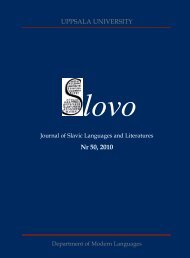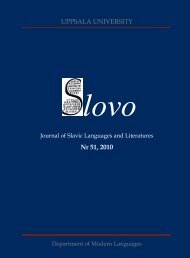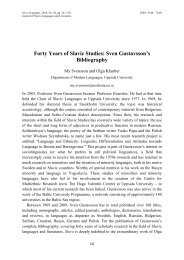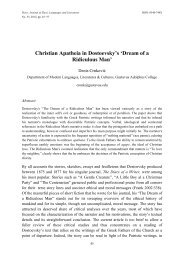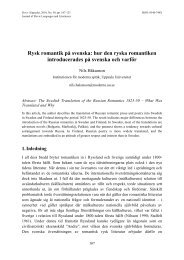Full text PDF - Index of - Uppsala universitet
Full text PDF - Index of - Uppsala universitet
Full text PDF - Index of - Uppsala universitet
Create successful ePaper yourself
Turn your PDF publications into a flip-book with our unique Google optimized e-Paper software.
Atle Grønn<br />
‘Byvalo’ and ‘used to’ as verbal quantifiers<br />
5. Habituals and aspect marking<br />
Čechov’s story in example (25) continues a few sentences later with the imperfective<br />
past (without byvalo):<br />
(31) [Бывало, прежде чем вырубить елку, дед выкуривает трубку, долго<br />
нюхает табак, посмеивается над озябшим Ванюшкой ... ] Срубленную<br />
елку дед тащил[up, uipf] в господский дом, а там принимались убирать ее<br />
[...] (Anton Čechov, “Van'ka”)<br />
(32) When he had cut down the Christmas tree, grandfather used[up] to drag it to<br />
the big house, and there set to work to decorate it [...]<br />
(33) Det huggede treet pleide[up] bestefar å trekke av sted til herskapshuset, og der<br />
gav de seg til å pynte det [...] (Norwegian)<br />
Semantically there is no particular difference in the temporal interpretation <strong>of</strong> the first<br />
sentence (present under byvalo) and second sentence (imperfective past) in the story<br />
above. In this case both the English and Norwegian translations express the habituality<br />
through a verbal quantifier. However, there seems to be an alternative way <strong>of</strong><br />
expressing habituality in Russian – through imperfective aspect alone, strictly<br />
speaking leaving the habitual operator covert.<br />
This comes as no surprise to aspectologists, since the habitual-iterative reading is<br />
cross-linguistically (e.g. both for Slavic and Romance languages) considered one <strong>of</strong><br />
the two main interpretations <strong>of</strong> the imperfective. Instead <strong>of</strong> focusing on a unified<br />
semantics for habitual and progressive aspect, I will argue that we may need both in<br />
one and the same sentence. While the habitus is always “imperfective”, the “lower<br />
aspect” can be either imperfective/progressive or perfective.<br />
In examples (31)–(33) above, the VP “to drag the Christmas tree to the big house”<br />
is presumably telic and therefore receives a “perfective” interpretation. For<br />
convenience, let us also look at the example below, where the embedded verb clearly<br />
calls for a perfective interpretation:<br />
(34) И скоро, скоро стала эта женщина моею тайною женой. Она<br />
приходила[up, uipf] ко мне каждый день, а ждать ее я начинал с утра.<br />
(Michail Bulgakov, “Master i Margarita”)<br />
(35) And soon, very soon, this woman became my secret wife. She used[up] to<br />
come to me every afternoon, but I would begin waiting for her in the morning.<br />
The standard view is to treat aspects as temporal relations between reference times and<br />
event times (or states). There are two “conflicting” aspectual relations involved in a<br />
sentence such as (34). The speaker refers to a past time interval t and says that the<br />
woman had a habitus s at that time t. The habitus s might also extend beyond t, thus<br />
indicating that the past reference time t is included in the habitus: t s. This is an<br />
imperfective relation. 7 However, there is also the question <strong>of</strong> how the events <strong>of</strong> the<br />
woman visiting the speaker are temporally interpreted. And here we get the opposite<br />
7 The idea <strong>of</strong> separating imperfective aspect and the habitus was suggested to me by Arnim von Stechow.<br />
71



